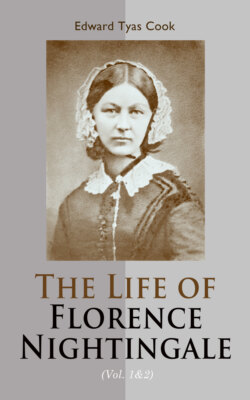Читать книгу The Life of Florence Nightingale (Vol. 1&2) - Edward Tyas Cook - Страница 30
III
ОглавлениеDuring her own stay in Rome, however, there was something which interested her more than Roman politics or Roman monuments. It was the philanthropic work of a Convent School. Every visitor to Rome knows the Trinità de' Monti. The flight of steps between the church and the Piazza di Spagna is celebrated alike for its own beauty and for the flower-girls and women in peasant-costume who frequent it. The church itself contains many fine works of art, and the choral service is one of the attractions of ecclesiastical Rome. The neighbourhood is rich in artistic and literary associations. Florence Nightingale had sympathetic eyes and ears for all these things; but what attracted her most was the convent attached to the church, with its school for girls, and (in another part of the city) its orphanage. She was broad-minded, as we have seen in an earlier chapter, in relation to church creeds. It was by works, not faith, or at any rate by faith issuing in works, that she weighed the churches. It was characteristic of the thoroughness of her mental character that during this sojourn in Rome she made a methodical study of Roman doctrine and ritual. Among her papers and note-books belonging to this time, there are careful analyses of the theory of Indulgence, of the Real Presence, of the Rosary, and so forth. She made, too, a careful collation of the Latin Breviary with the English Prayer-Book. She summed up her comparative study of the churches in this generalization: “The great merit of the Catholic Church: its assertion of the truth that God still inspires mankind as much as ever. Its great fault: its limiting this inspiration to itself. The great merit of Protestantism: its proclamation of freedom of conscience within the limits of the Scriptures. Its great fault: its erection of the Bible into a master of the soul.” Her deep sense of the self-responsibility of every human soul kept her free from any inclination to Roman doctrine; but she was profoundly impressed by the practical beneficence of Roman sisterhoods. An example of such beneficence she found in the school and orphanage of the Dames du Sacré Cœur. She had picked up a poor girl called Felicetta Sensi, and procured her admission as a free boarder, paying for her care and education for many years. She formed a warm attachment to the Lady Superior, the Madre Sta. Colomba. She studied the organization, rules, and methods of the large school, and for ten days she went into Retreat in the Convent.39 Her intercourse with the Madre Sta. Colomba, of whose talk and spiritual experiences she made full and detailed notes, made a very deep impression on her mind. She studied rules and organization, but, as in all her studies, she was seeking a motive, as well as, and indeed more than, a method. Many years later, a friend wrote to her: “It seems to me that the greatest want among nurses is devotion. I use the word in a very wide sense, meaning that state of mind in which the current of desire is flowing towards one high end. This does not presuppose knowledge, but it very soon attains it.”40 This was a profound conviction of her own, often expressed, as we shall hear, in her Addresses and Letters of Exhortation in later years. What she set herself to study at the Trinità de' Monti was the secret of devotion. She made notes of the Lady Superior's exhortations; of the spiritual exercises which were enjoined upon novices; of the forms and discipline of self-examination. She sought to extract the secret, and to apply it to the inculcation of the highest kind of service to man as the service of God. For many years the thought in her mind was to be the foundation of some distinctive order or sisterhood; and though in the end she came to be glad that she had not done this, she never abandoned the high ideal which was behind her thought. Nor, though in some ways and in some cases she came to be disillusioned about nursing sisterhoods, did she ever cease to speak with admiration of what she had seen and learnt in some of them. She thought more often, and with more affectionate remembrance, about the spirit of the best Catholic sisterhoods than of Kaiserswerth, or indeed of anything else in her professional experience.
In such studies upon the Trinità de' Monti in the winter of 1847–48, she was taken, as she said in a note of self-examination, out of all interests that fostered her “vanity”; it was her “happiest New Year.” “The most entire and unbroken freedom from dreaming I ever had,” she wrote at a later time. “Oh, how happy I was!” And so again, looking back after twenty years, she wrote: “I never enjoyed any time in my life so much as my time at Rome.”41
